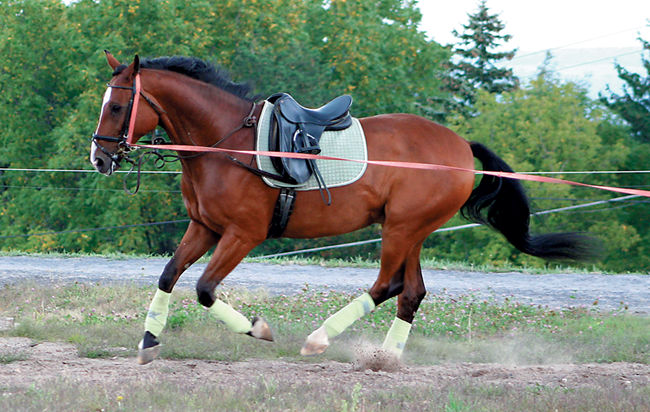The market is saturated with products to help people lose weight. But if you read the fine print, you’ll notice they all say the same thing: “For best results, combine with a low calorie diet and daily exercise.” The same is true for your horse.

An overweight horse strains his joints with every step and becomes more prone to insulin resistance, and fat cells can also promote bad inflammation. It’s easy to see why weight loss is paramount to your horse’s longevity.
Start Simple.Supplementing antioxidants helps reduce inflammation from fat cells. They’re readily available in most commercial supplements, but we would focus on the nutrients that support weight loss. Avoid multi-ingredient products, so you don’t risk an “overdose” on something in the process. You may even save a few dollars.
The key antioxidants are: vitamin E, vitamin C, and beta carotene (which the horse converts to vitamin A), all of which are found in grass but are lost in hay storage. (See May 2013 antioxidants.) Other nutrients that support weight loss are:
- Magnesium
- Chromium
- Psyllium
- Omega 3 fatty acids.
MAGNESIUM. Of all the nutrients believed to help the easy-keeper horse, the best responses come from magnesium. Forages grown in areas of acidic or clay soils are typically low in magnesium. Compound this with low bioavailability, and your horse may be getting enough magnesium to prevent a full-blown deficiency but not enough to maintain normal body functioning.
Because calcium will compete with magnesium for absorption, you should check the horse’s entire diet for magnesium and calcium levels, then supplement. Close to a 2:1 ratio of Ca:Mg (twice as much calcium as magnesium) should do the trick.
It always makes sense to test your hay to know its contributions. If this isn’t practical, offer a full-sized horse (1,100 lbs.) a conservative amount, say 10 grams of magnesium per day. Continue supplementing until you see fat pads start to diminish (this can take months), then reduce the amount of magnesium by half as a maintenance dose.

Chromium.Chromium is a component of glucose tolerance factor (GTF) that enhances insulin’s ability to remove glucose from the blood and place it into the cells, reducing the need for extra insulin.
Although research isn’t as strong as for magnesium, chromium may be worthwhile. Add 1 to 2 mg per 250 lbs. of body weight, especially where alkaline soils lead to poor chromium uptake by grasses. Choose organic sources (yeast or picolinate) for best absorption.
PSYLLIUM.Psyllium husks of the Plantago ovata plant contain nearly 70% water-soluble fiber. Psyllium quickly absorbs water inside the small intestine (foregut), forming a gel that adds bulk and volume and has the ability to interfere with glucose absorption (from starch and sugar digestion). When blood glucose is reduced, insulin secretion from the pancreas is also reduced.Although most research has been done with humans, a recent study revealed that psyllium husks create the same glucose absorption inhibition in horses and lead to lowered blood insulin levels.

Supplement pure psyllium husks (generally 99.5% pure). There’s little variance among brands of psyllium, but we prefer to feed pellets, as powders turn into an unpleasant gel.
Feed a serving of about 90 grams per day, which is equivalent to three ounces by weight or six fluid ounces in a measuring cup, with each concentrated meal.
OMEGA 3 FATTY ACIDS. The omegas are potent anti-inflammatory molecules. Flax and chia seeds contain concentrated levels of the omega 3 fatty acid known as alpha-linolenic acid (ALA).
Flaxseeds should be ground since the seeds are too small to be adequately chewed. So, we suggest getting a ground flaxseed supplement that is “stabilized” against rancidity with a small amount of calcium added to correct for the naturally higher levels of phosphorus in flaxseed. Avoid products that contain added cereal grains.
Chia seeds offer a similar level of omega 3s without the need to grind them. When exposed to water, however, they immediately form a gel.
The Jury Is STill Out. Other ingredients are touted as helpful, although the research behind them isn’t as strong. Still, we think they’re worthy of consideration.
Cinnamon has increased insulin sensitivity in animal and human studies. The results with horses weren’t conclusive, although this may be due to low dosing. Horses were fed only one teaspoon (approximately 3000 mg) per day in the study done at Lousiana State, a level on par with human dosages.
Lipoic acid can improve insulin’s effectiveness and has antioxidant benefits. Fresh grass contains sufficient amounts but, in hay, lipoic acid is lost through oxidation. Dosage has not been determined.
Chasteberry (vitex agnus-castus) is commonly fed to horses battling insulin resistance. Our previous field trials with this product have shown positive results, following manufacturer dosages. However, scientific evidence to support this observation is lacking.

BOTTOM LINE. Our chart on p. 4 includes products we like to support weight loss. However, you still have to increase exercise and cut calories. Unfortunately, there are no magic-bullet weight-loss remedies.
Article by Contributing Nutrition Editor Dr. Juliet Getty.





